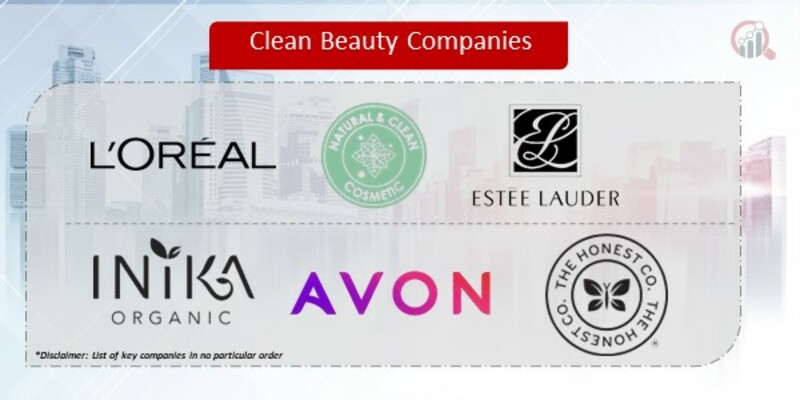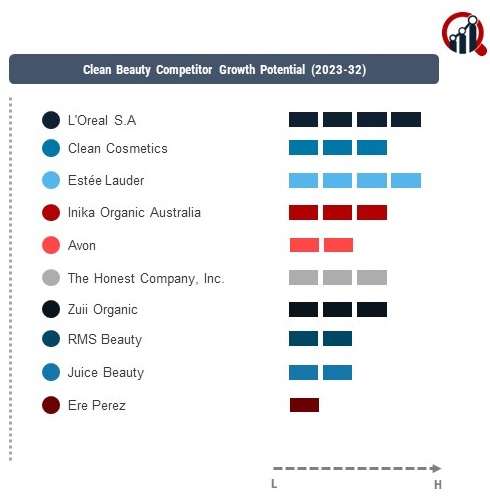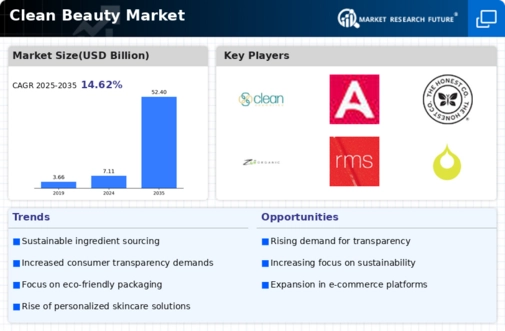Top Industry Leaders in the Clean Beauty Market
 competitive landscape of the clean beauty market is shaped by key players that significantly influence the production, marketing, and distribution of beauty and personal care products adhering to clean and sustainable principles. As of 2023, major companies playing a crucial role in this market include The Estée Lauder Companies Inc., L'Oréal S.A., Unilever, Coty Inc., and Johnson & Johnson.
competitive landscape of the clean beauty market is shaped by key players that significantly influence the production, marketing, and distribution of beauty and personal care products adhering to clean and sustainable principles. As of 2023, major companies playing a crucial role in this market include The Estée Lauder Companies Inc., L'Oréal S.A., Unilever, Coty Inc., and Johnson & Johnson.
Key Players:
L'Oreal S.A
Clean Cosmetics
Estée Lauder
Inika Organic Australia
Avon
The Honest Company, Inc.
Zuii Organic
RMS Beauty
Juice Beauty
Ere Perez
Strategies Adopted:
The clean beauty market revolve around product innovation, brand transparency, sustainability practices, acquisitions, and digital marketing. Product innovation is crucial, with companies investing in the development of clean formulations, natural ingredients, and eco-friendly packaging to meet the rising demand for clean beauty products. Brand transparency involves providing clear and detailed information about ingredients, sourcing, and manufacturing processes to build trust with consumers. Sustainability practices include adopting ethical sourcing, reducing carbon footprints, and implementing eco-friendly packaging solutions to align with clean beauty principles. Acquisitions of clean beauty brands or collaborations with emerging companies allow established players to diversify their portfolios and tap into the growing clean beauty market. Digital marketing strategies focus on engaging consumers through online platforms, social media, and e-commerce to reach a broader audience and communicate the values of clean beauty.
Market Share Analysis:
The clean beauty market include brand reputation, product efficacy, pricing strategies, distribution networks, and sustainability practices. Brand reputation plays a pivotal role, with consumers increasingly choosing products from companies known for their commitment to clean and ethical beauty standards. Product efficacy, in terms of performance and clean formulations, is essential for building and retaining consumer trust. Pricing strategies, whether positioned as premium or accessible, impact market share by appealing to specific consumer segments. Efficient distribution networks, including partnerships with retailers and online platforms, contribute to market reach and accessibility. Sustainability practices, such as cruelty-free certifications and recyclable packaging, also play a significant role in consumer purchasing decisions.
News & Emerging Companies:
The clean beauty market has witnessed the emergence of new companies and trends responding to the growing demand for sustainable and transparent beauty products. Emerging companies often focus on niche segments, such as vegan beauty, zero-waste packaging, or innovative formulations, to differentiate themselves in the competitive landscape. Additionally, advancements in technology, such as augmented reality (AR) for virtual try-on experiences, have gained traction among emerging players seeking to enhance the online shopping experience for clean beauty consumers.
Industry Trends:
Industry trends in the clean beauty market highlight continued commitments to sustainability, digital transformation, and community engagement. Many companies are investing in sustainable sourcing, renewable energy, and biodiversity initiatives to align with the industry's focus on environmental responsibility. Digital transformation efforts include enhancing online platforms, implementing artificial intelligence (AI) for personalized recommendations, and leveraging data analytics to understand consumer preferences better. Community engagement involves collaborations with influencers, beauty communities, and non-profit organizations to amplify brand messaging and foster a sense of community among clean beauty enthusiasts.
Competitive Scenario:
The clean beauty market remains dynamic, with established players adapting to changing consumer preferences and emerging companies contributing to innovation. Market dynamics are influenced by factors such as increasing consumer awareness, regulatory changes, and the global shift towards sustainable and ethical beauty practices. The resilience of the market is evident in its ability to evolve, with companies addressing the diverse needs of consumers seeking clean, transparent, and effective beauty solutions.
Recent Development
The clean beauty market is the increased focus on circular beauty practices, emphasizing recyclability, refillability, and waste reduction. Major players have been implementing initiatives to minimize the environmental impact of beauty product packaging, including the introduction of refill stations, recyclable materials, and awareness campaigns to educate consumers on responsible disposal. This development aligns with the broader industry trend of fostering a circular economy and reducing the beauty industry's environmental footprint.










